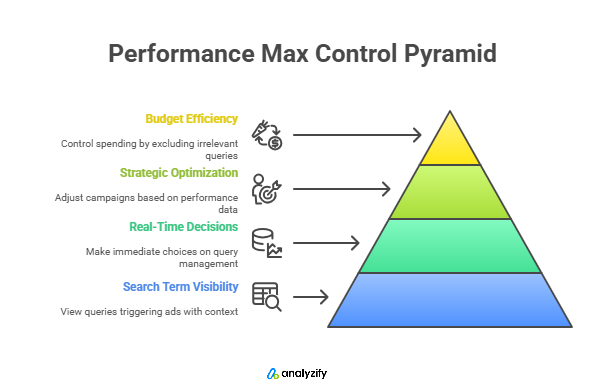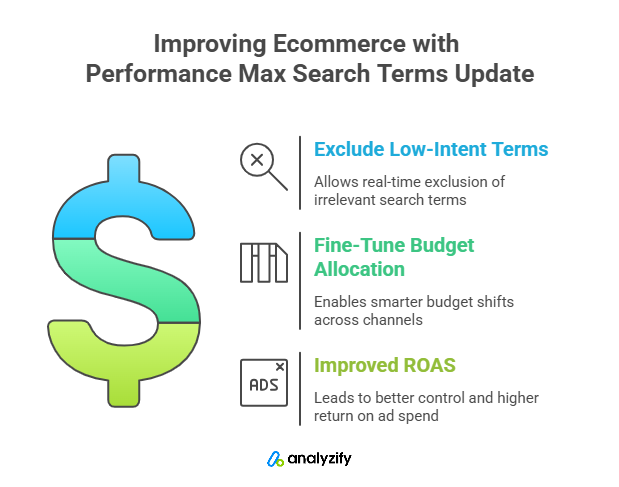Performance Max campaigns have often been frustrating because there was no way to see which search terms triggered your ads.
This made it hard to optimize and easy to waste budget on the wrong clicks.

Now, Google has changed that. With the latest update, you can finally see the search terms that trigger your Performance Max ads, just like in regular Search campaigns.
In this post, you’ll explore what’s new with the update, why it is important for ecommerce and small business owners, and how to use it to get better results from your campaigns.
What’s New with Performance Max Search Terms
Google has finally added search-term visibility to Performance Max. This change makes it easier to understand what’s triggering your ads and gives you more control.
Key updates:
- Search terms now show in the standard Search Terms report . You can see PMax queries alongside your Search campaigns now. Here are all the metrics include:
- Impressions
- Clicks
- CTR
- CPC
- Conversions
- Add negative keywords directly from the report: No more digging through settings or relying only on account-level exclusions. Just hover and exclude terms instantly at the campaign or account level.
- Part of a broader negative keyword rollout: This builds on earlier changes that introduced campaign-level negative keywords in PMax. Now, you can manage queries with the same precision you’re used to in Search campaigns
Rollout status:
- It’s gradually rolling out, so not all accounts will see it yet
- If it’s not in your account, check back soon, it’s expanding quickly
How Performance Max Search Terms Change the Game

Before this update, Performance Max Search Terms were hidden. Advertisers had to trust the algorithm without knowing which queries triggered their ads.
This lack of insight made it hard to judge traffic quality, control budget waste, or optimize based on intent.
Now, that gap is closed. You can view Performance Max Search Terms with full context, metrics, performance, and relevance. This allows real-time decisions: which queries to keep, which to exclude, and where to adjust strategy.
More importantly, this changes the nature of PMax. It’s no longer a “black box.” You’re no longer locked out of query-level control.
The data is visible, actionable, and accessible, like it should have been from the start.
For advertisers managing tight budgets or working in competitive verticals, this visibility isn’t just helpful.
It’s essential. You can finally shape your campaigns around what’s actually driving performance.
Supporting Updates Behind Performance Max Search Terms
The Performance Max Search Terms update is part of a broader shift toward more control in PMax campaigns. Google has rolled out several changes in recent months that build on each other:
- Campaign-level negative keywords
Launched in Q1 2025, this update lets you:- Add negative keywords directly at the campaign level
- Move beyond account-wide exclusions
- Use up to 10,000 negative keywords per campaign
- New transparency features (April 2025)
These updates give deeper insight into how your ads perform:- Channel-level reporting shows performance by surface (Search, Shopping, YouTube, etc.)
- Asset-level metrics break down how individual creatives are performing
- A new “source” column in the Search Terms report shows where queries came from (channel or asset group)
Together, these updates mark a turning point for Performance Max:
- From black-box automation
- Toward hands-on control and transparency
- With Performance Max Search Terms at the center of it all
Bonus Content: Adding negative keywords in your Performance Max campaignscomes with a lot of benefits. Discover the “The Ultimate Guide to Negative Keywords in Performance Max Campaigns” with step-by-step instructions.
How To Use Performance Max Search Terms in Google Ads
You can now view and act on Performance Max Search Terms directly in your Google Ads account. Here’s how to use the feature effectively:
What This Update Mean For Ecommerce Businesses

The new visibility update into Performance Max search terms is especially valuable for ecommerce brands and small-to-midsize businesses using Google Shopping Ads in 2025.
Below are some of the benefits of Performance Max search terms for ecommerce:
- Exclude low-intent and competitor terms dynamically: PMax often matched ads to broad or loosely relevant queries. Now, with direct access to search-term data and inline negative keyword options, you can identify and exclude low-intent queries or competitor brand names in real time. This helps reduce wasted spend and sharpens your campaign focus.
- Fine-tune budget allocation across channels: Performance Max campaigns span multiple channels, Search, Shopping, YouTube, Display, and more. The new “source” column in the search terms report lets you trace where specific queries originated. This extra context allows smarter budget shifts between channels, especially when one surface consistently outperforms others for certain queries.
- Improved ROAS through refined control: More search-term insight means better control over how your ads are triggered. That leads to cleaner targeting, fewer irrelevant clicks, and ultimately a stronger return on ad spend (ROAS). For SMBs managing lean budgets, this update levels the playing field by enabling granular optimization without requiring an agency or advanced tools.
What to Expect from Upcoming Google Ads Updates
The March update is just the beginning. Google has more updates planned to expand control and insight in Performance Max:
- Full rollout by mid-2025
- The search-term report is rolling out in phases
- If you don’t have access yet, it should appear soon
- More detailed reporting ahead
- Google is working on deeper channel- and asset-level insights
- Useful for understanding performance across YouTube, Shopping, and Display
- Google Marketing Live announcements
- Expect future upgrades to reporting, diagnostics, and automation tools
- These may build directly on the new Performance Max Search Terms data
Conclusion
Performance Max is no longer a black box. With search-term data, negative keywords, and improved reporting, advertisers now have real control.
If you haven’t yet, check your PMax setup, explore the new data, and start refining your exclusions. These updates can help cut waste and improve results.
Read More:

































